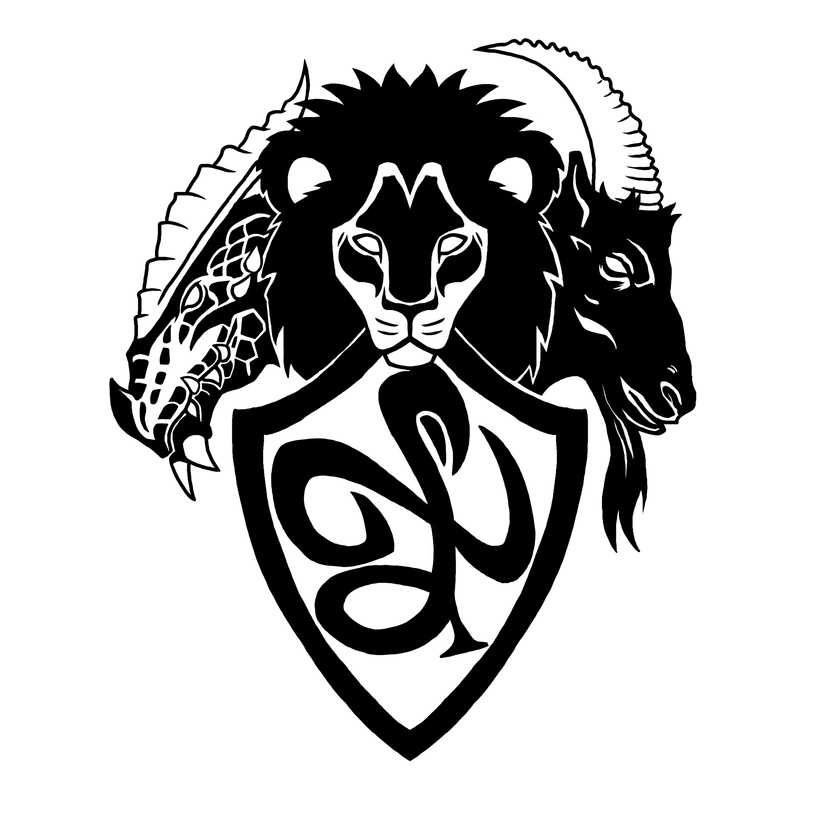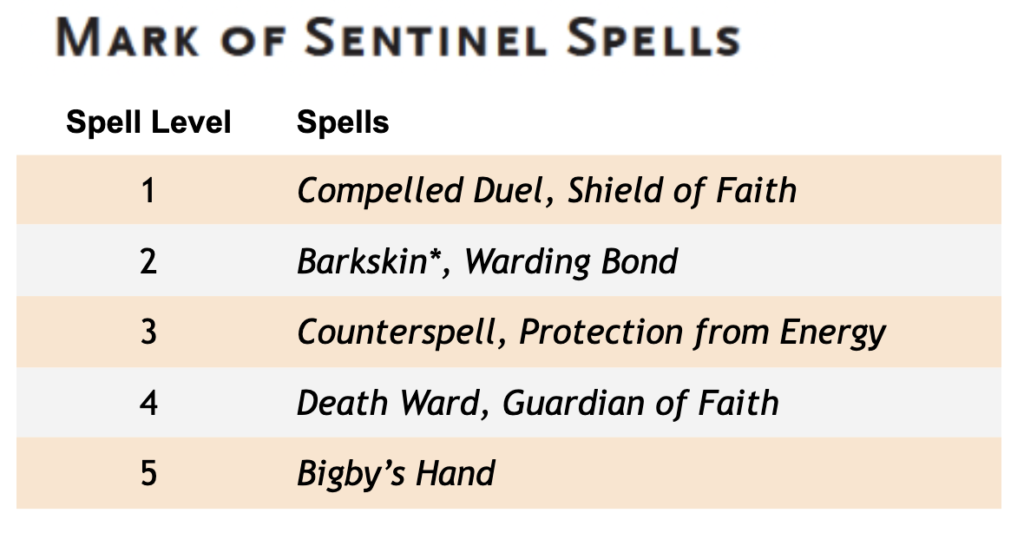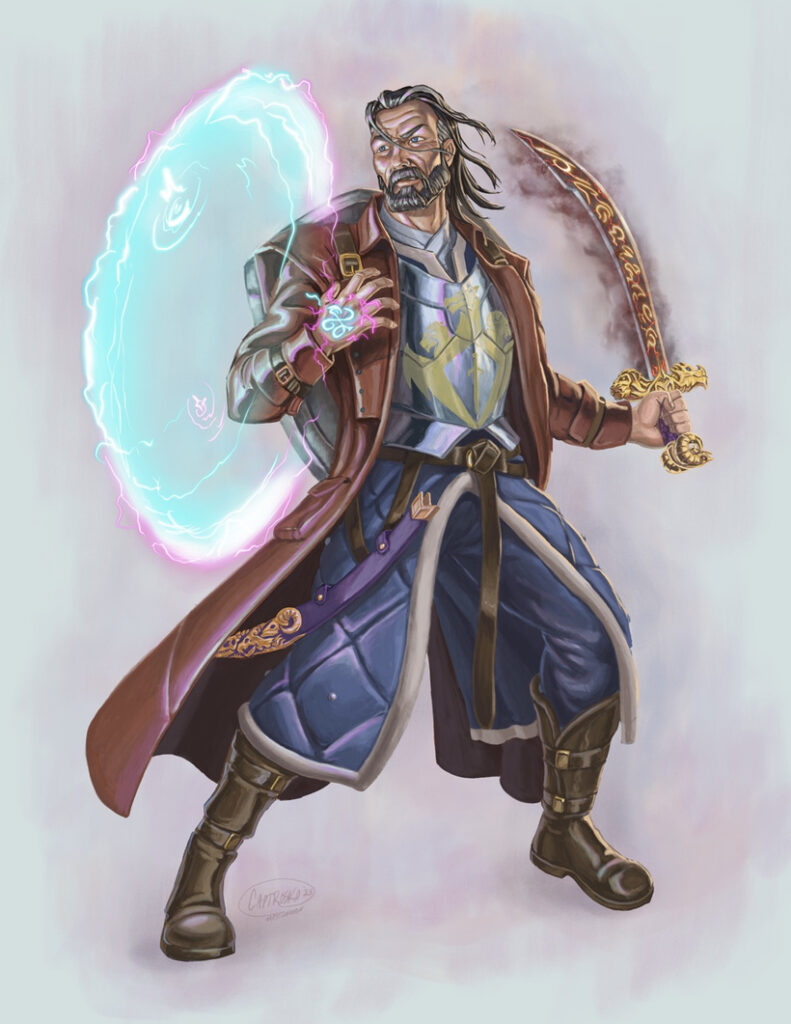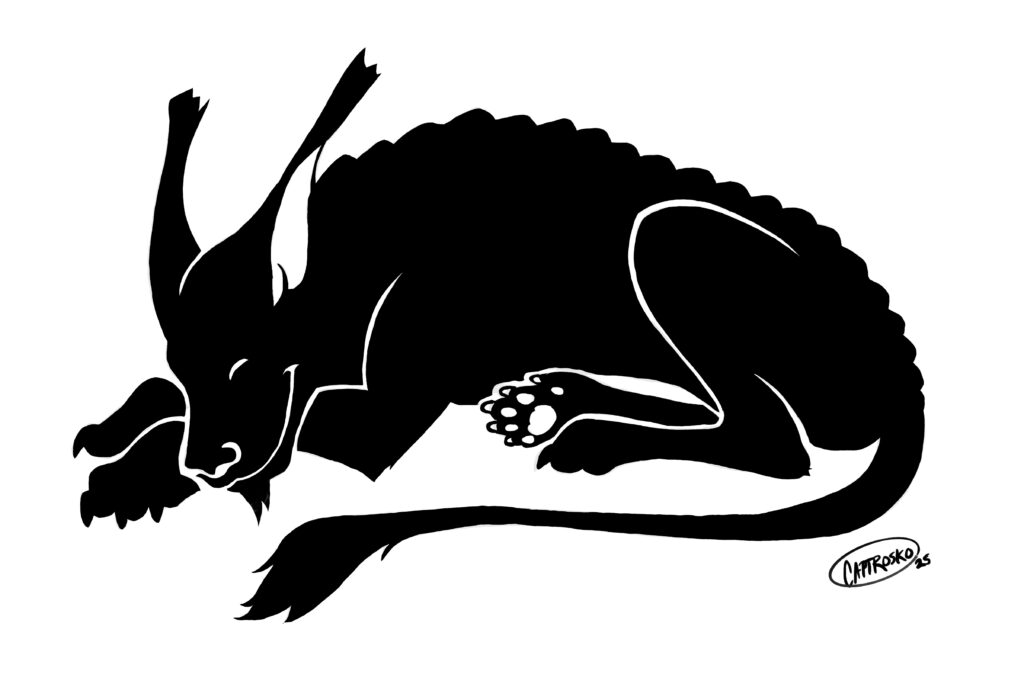
A King’s Bounty with a pinch of vazilla, as always. But what’s wrong? I can see it in the slump of your shoulders, my friend; something’s weighing you down. Tell me your troubles. A burden shared is a load lifted. And if I can’t help you solve your problem… Perhaps I know someone who can.
House Jorasco possesses the Mark of Healing. Those who carry this Mark can cure disease and heal physical injuries. The gifts of House Ghallanda are subtler than that. Rather than healing existing afflictions, the Mark of Hospitality grants the ability to provide sustenance and comfort—to maintain health and happiness through times of hardship. Those who bear the Mark can provide food and shelter, and settle disputes before they result in violence. In its earliest days, House Ghallanda used the Mark of Hospitality to help travelers survive the many dangers of the Talenta Plains. Since then, the House has spread across Khorvaire. As innkeepers and bartenders, as bakers, brewers, and chefs, House Ghallanda continues to provide sustenance, shelter, and comfort for those in need.
In many ways, House Ghallanda is the happiest Dragonmarked House. The majority of its heirs take real joy in the work that they do. A Ghallanda innkeeper takes pride in providing a sanctuary from the grim world beyond their walls. A Ghallanda chef hopes each meal they prepare will give someone a moment of joy. Yes, they charge for their services, because they have to in order to continue to provide them. But even as Ghallanda maintains casinos and luxurious resorts for the wealthy elite, it still continues to look out for those in need. The Wandering Inn is an ancient tradition, traveling across the Talenta Plains and helping travelers. There is no Wandering Inn in the Five Nations, but there are Wanderers. Some Ghallanda heirs know exactly what they want to do in life. They train in culinary arts or hostel management, going straight from their training to service in a thriving establishment, working their way up from within. But other heirs wish to see more of the world before they lay down roots. These heirs can choose the path of the Ghallan—the “Helpful Hound”—or as they are generally called, the Wanderers. Ghallans are charged to travel. They’re encouraged to make as many friends as possible, and to try as many types of food as possible—to learn recipes they might use in the future. But like the Wandering Inn, the primary charge of the Wanderer is to help those in need. This might mean giving goodberries to a starving family, offering a fugitive a temporary shelter in an extradimensional space, or stepping in to mediate a dispute before blood is shed. Wanderers aren’t expected to have an answer for every problem, or to be able to provide long-term support. But they strive to make a difference, to ease burdens and to help where they can. When a Wanderer does settle down, they bring those experiences with them. How is it that the bartender at The Dog & Biscuit knows Prince Oargev? I’ll tell you. It was a few years back, with the war still going then. It was raining cats and dogs… and I don’t mean that as a figure of speech. Lamannia was coterminous and we were in a manifest zone, and, well, I’ve never seen anything else like it. The Prince and I were traveling in the same Orien coach, him in the private chamber mind you, when a brace of falling wolfhounds just shatter the thing. We’re out in the open now, and it’s clear that we’re either going to be crushed by falling beasts or eaten by the ones already on the ground. So I raise my Tiny Hut and invite the prince and the coachman inside, and we spend the next hour eating morsels and playing cards. By the time the storm was over, well, I’d won a fine estate near Metrol and a friend for life. Too bad the manor was lost in the Mourning, but of course the Korth wouldn’t have let me keep it…
The innate, ongoing gifts of the Mark of Hospitality include an intuitive bonus to using Cook’s Utensils and Brewer’s Supplies. As an heir carrying the Mark, you have an innate appreciation for flavor, as well as an instinctive sense for proper timing and ratios. The Mark also provides an intuitive bonus to Persuasion. This is less about active manipulation, and instead reflects the fact you’re inherently easy to like. People who carry the Mark of Hospitality have a disarming charm; it’s why it’s so easy to open up to the Ghallanda bartender.
In playing a Ghallanda heir, consider the road you’re on. Most of your cousins know exactly what they want, and they’re willing to take the slow road to get there—cleaning tables, working as cooks, bellhops, or stewards until they eventually have the opportunity to own their own establishment. What is it you dream of? Do you want to own an inn? If so, do you already have a name for it? Are you always tracing out the floorplan or doodling ideas for the inn sign? Would you rather be a brewer or a chef, in which case you might be searching for the perfect flavor or some legendary ingredient? Are you a Ghallan Wanderer, always looking for a way you can lend a hand? Or are you finding your own path—not committed to any tradition or duty, just waiting to see where fortune takes you? Beyond this, consider where you’ve been and who you met along the way. Talk with the DM and ask if you have any interesting friends who might owe you a favor—or who might be expecting a favor from you!
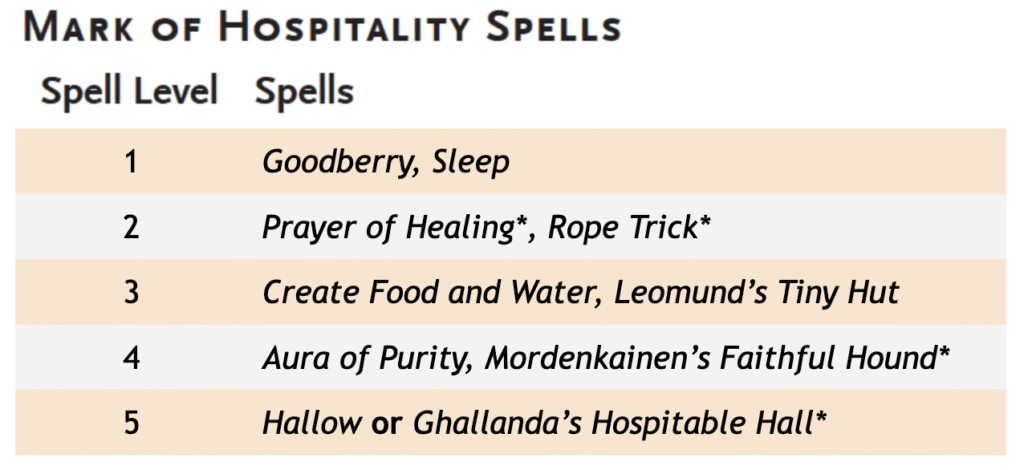
THE MARK OF HEARTH AND HOME
The Mark of Hospitality has three aspects: Food, Shelter, and Soothing. The ability to provide nourishing food is a key aspect of the Mark of Hospitality. Anyone who bears the Mark has the ability to Purify Food and Drink. The greater gifts of the Mark allow heirs to produce food from thin air. When cast through the Mark, Goodberry is called Mighty Morsel; rather than producing berries, the spell creates ten pellets that provide the sequential flavors of a three course meal. Prayer of Healing is called Fortifying Feast: when cast using the Mark, the ten minute casting time involves conjuring a small meal which must be consumed by the beneficiaries. Ghallanda’s Hospitable Hall allows the caster to create a meal for up to thirty people! For all of these food related spells, the caster must make a Wisdom (Cook’s Utensils) check to determine the quality of the meal; 10 is acceptable, 15 is excellent, and 20 or higher is superb. When casting Create Food and Water the caster has disadvantage on this check; this food tends to be bland, and it takes an exceptional chef to imbue it with compelling flavor.
Providing shelter is a second key aspect of the Mark of Hospitality. The Tiny Hut of the Lesser Mark conjures a simple physical shelter that endures for eight hours. It’s an excellent way to escape from unexpected bad weather. There’s a branch of the Hosteler’s Guild that specializes in what we would understand as Glamping—a Ghallanda guide takes you through an interesting stretch of wilderness, producing a Tiny Hut as a secure shelter for the night and preparing a fine meal. Rope Trick has a short duration that prevents it from being terribly useful as a commercial service, but it is the stepping stone toward the most iconic power of the Mark: Ghallanda’s Hospitable Hall. This allows an heir with the Greater Mark of Hospitality to open a portal to a small extradimensional space, with furnishings and decor drawn from the imagination of the heir. The 24 hour duration allows any heir with this power to run their own “pop-up” business. Aside from putting a roof over one’s head, the Mark of Hospitality also helps to secure that shelter. Any heir with the Mark of Making can cast Unseen Servant. This is said to draw off a fragment of the heir’s own spirit, calling on their own helpful nature to offer assistance. Heirs with the Lesser Mark can conjure a more palpable force: Mordenkainen’s Faithful Hound, or as it’s called when cast in this way, Ghallan Guardian. This typically takes the shape of a spectral Blink Dog formed from the swirling lines of a dragonmark, though occasionally heirs manifest unique shapes for their guardian; Baron Yoren is known to summon a guardian Clawfoot raptor. A Ghallanda innkeeper may offer to cast a Guardian for a customer who seems to have a need for a little extra security for the night. The final gift is quite rare: the ability to cast Hallow, drawing on the power of the Mark to protect an area from malign forces. No heir can cast both Hallow and Ghallanda’s Hospitable Hall; even player characters must choose which of the two spells they have access to.
The final aspect of the Mark of Hospitality is the ability to soothe others, helping people enjoy their food and shelter. At its simplest level, this is seen in the innate bonus to Persuasion granted by the Mark. Any experienced heir can extend this to cast Calm Emotions, which has brought an end to countless bar fights. Some heirs learn how to concentrate this effect, channeling this soothing energy into the ability to cast Sleep.
What about Prestidigitation? Prestidigitation has always been associated with the Mark of Hospitality. It was one of the optional spells tied to the Mark in the original Eberron Campaign Setting book, and it was a gift of the Mark in Eberron Rising From The Last War. However, Forge of the Artificer has dropped it, instead allowing the bearer of the Mark to cast Calm Emotions. Prestidigitation is an extremely useful spell for an Innkeeper or chef: it allows them to heat, chill, or flavor food and drink, as well as to clean floors and dishes with a gesture. This article already imposes a number of changes to canon in the revised Spells of the Mark list, and I prefer not to change the traits as well. As a result, this article introduces the Innkeeper’s Gloves as a common focus item that allows a Ghallanda heir to cast Prestidigitation. The point being that almost every marked heir CAN cast Prestidigitation—they’re just doing it through a focus rather than through the unassisted Dragomark.
Kanon vs Canon. My goal with these articles is to strengthen the story of the Dragonmark, ensuring that its abilities paint a consistent picture and support the services the House provides in the world. With the Mark of Hospitality, this has resulted in me changing four Spells of the Mark from those that will appear in Forge of the Artificer.
- At 2nd level, I’ve replaced Aid and Enhance Ability with Rope Trick and Prayer of Healing. I like Prayer of Healing because the ten minute casting time allows it to be presented as a form of Heroes Feast (which was originally granted by the 3.5 Greater Mark of Hospitality); the idea being that the heir actually prepares a meal that strengthens the party. This is more compelling to me than the random boost of Aid. Meanwhile, Rope Trick plays to the idea of providing shelter and foreshadows Ghallanda’s Hospitable Hall.
- At 4th level, I’ve replaced Mordenkainen’s Private Sanctum with Mordenkainen’s Faithful Hound. This was a difficult decision; Ghallanda inns would benefit from being shielded by Private Sanctum. But Private Sanctum is a spell that becomes permanent if cast enough times, which means that if Ghallanda had it, people would be paying them to cast it for them. Nobles would want Private Sanctums in their homes. And for that reason, I feel that Private Sanctum should be a gift of the Mark of Warding, not the Mark of Hospitality. KUNDARAK is the house you’re supposed to be paying for magical security, not Ghallanda. Furthermore, Private Sanctum primarily protects against Divination and Teleportation, which again feels more like WARDING. By contrast, the Mark of Hospitality already has the ability to cast Unseen Servant. Mordenkainen’s Faithful Hound is essentially a strengthening of that existing spell; it fits the Blink Dog iconography of the House; and having an Innkeeper put a dog at your door for the night feels appropriate without stepping on the toes of Kundarak.
- At 5th level, I’ve added the option of Ghallanda’s Hospitable Hall. Hallow is a powerful spell, but it’s very limited in its use; it has a 24 hour casting time and a 1,000 gp casting cost; it’s not something an adventurer can use on a regular basis. Beyond this: Mordenkainen’s Magnificent Mansion was one of the original options for the Greater Mark of Hospitality in the 3.5 Eberron Campaign Setting, and for me it’s always been part of the flavor of House Ghallanda. Part of the point of the Wandering Inn is that you have mansions inside wagons. With the current structure it’s awkward to give a Dragonmark the ability to cast a 7th level spell; so I’ve created Hospitable Hall as a slightly weaker version of Magnificent Mansion. Note that this is a spell that is only supposed to be available to characters with the Mark of Hospitality—emphasized by making the Mark a component of the spell. For most people, this is still a 7th level effect.
As always, using kanon content is something that requires DM approval. This is how I use the Mark of Hospitality in MY campaign, but other DMs may prefer to rely on canon material.
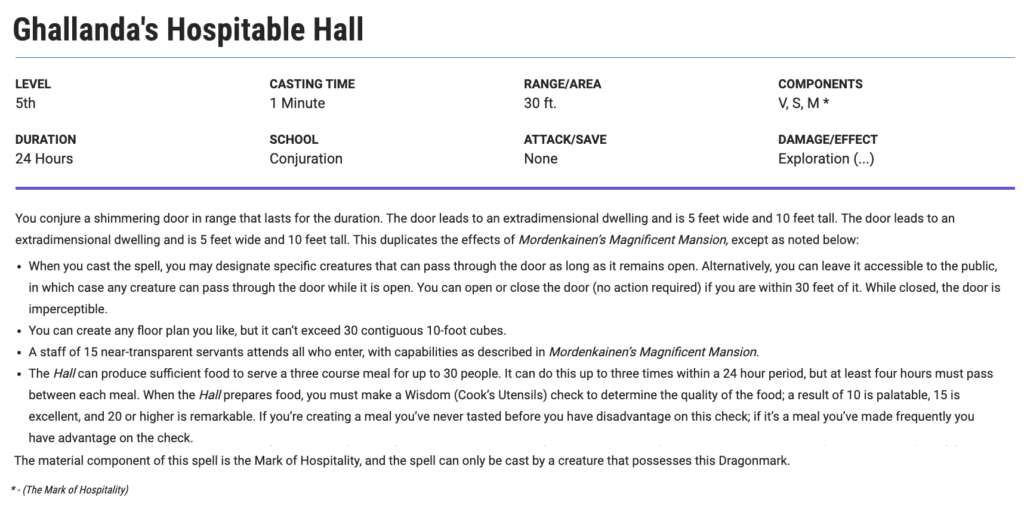
Focus Items
Ghallanda heirs employ the common focus items presented in Exploring Eberron—Dragonmark Channels, Dragonmark Reservoirs, and Channeling Rods. Exploring Eberron also introduces the Ghallanda Cauldron (which reduces the time required to prepare a meal) and the Manor Key, which preserves the 3.5 tradition of Ghallanda Magnificent Mansions. Exploring Eberron also highlights the idea that existing magic items can be reflavored as focus items, calling out the Ghallan Jug as a form of Alchemy Jug that draws on the Mark of Hospitality. In addition to these, here’s a few new focus items to play with.
Bag of Bounty
Wondrous Item, Uncommon
This leather bag has three charges. A creature with the Mark of Hospitality can take a Magic Action to open the bag and cast Create Food and Water, expending one charge in the process. When using the Bag, a creature can make a Wisdom (Cook’s Utensils) check to determine the quality of the food; they don’t suffer the disadvantage that normally applies when casting Create Food and Water with the Mark of Hospitality. The Bag of Bounty recovers 1d3 charges at dawn.
Hosteler’s Anchor
Wondrous Item, Uncommon (requires attunement by a creature with the Mark of Hospitality)
The Hosteler’s Anchor is a stone brick engraved with the Mark of Hospitality. If the anchor is placed in an extradimensional space created by the creature attuned to Anchor—such as a Magnificent Mansion, Hospitable Hall, or Rope Trick—it can help maintain the space in the absence of the caster. When the duration of the spell expires, the caster can immediately refresh the spell through the Anchor. This requires the creator to expend the appropriate spell slot or charge from a magic item, but it requires no action on the part of the creator. The creator can even set this effect to occur even if the creator is unconscious, although they must have the appropriate spell slot or item charge available to be spent. A creature who possesses both a Hosteler’s Anchor and a Manor Key can attune to both items using a single attunement slot.
Innkeeper’s Gloves
Wondrous Item, Common
If you possess the Mark of Hospitality, you may use a Magic Action to cast Prestidigitation while wearing these gloves.
THE HISTORY OF HOUSE GHALLANDA
There are many ways to die on the Talenta Plains. The easiest is to stand still, to wait for malign spirits and hungry ghosts to find you. But even those who stay in motion face many dangers. Sometimes there’s no shelter to be found when predators prowl or when strange storms are brewing. Sometimes mischievous fey or malevolent fiends steal food or spoil it, condemning travelers to misery and death. The Talenta tell countless tales of those who have fallen on their journeys, warning the young of the dangers that lie ahead of them. Even in these grim tales, there’s always hope. There are hidden oases and helpful allies. Ustukata is the inner spirit that lifts the tired foot, a possessing spirit that animates those too exhausted to carry on and drives them on until they reach safety. Ghallanda is the helpful hound that appears where needed the most, the blink dog who appears with food for starving travelers and guides those who have lost their way. In one tale, a wanderer named Kullikora is caught in a blood storm with her family and friends. Their supplies are ruined and they’re driven off the path of safety. The travelers know that when the storms come again, it will consume their spirits and leave their dancing bones behind—and even if they could find shelter, they would soon starve. Kullikora wanders away from the group and begs the spirits to show mercy to those she loves, offering herself as a sacrifice in exchange for their safety. Ghallanda appears before her, and leads her to a door in the side of a mound of sand. On the other side of the door, Kullikora finds a vast billowing tent filled with soft cushions and piled high with food and drink. She leads her family to this sanctuary and they rejoice, but there is still concern. They have shelter tonight, but they are far from the safe paths; what will happen tomorrow? Ghallanda tells her you didn’t FIND this sanctuary, Kulli. You created it from the love in your heart. You carry it with you, and you can open the door whenever you wish. But you said you would lay down your life for others, and I will hold you to that. You carry the sanctuary within, but you must open that door to those in need. Continue on. Wander where you will. But help those in need, for you are the shelter from the storm.
The tale of Kullikora is the oldest known reference to the Mark of Hospitality, and while it’s impossible to date it precisely, the scholars of the Twelve believe it is the oldest reference to any Dragonmark. Canonically the Mark of Hospitality first manifested around 3,200 years ago, just before the Marks of Shadow and Death appeared in Aerenal. It’s said that Kullikora wandered the Plains helping those in need, and as she did so she met other halflings who had also been blessed in moments of dire need. Together they established a caravan that would be a mobile sanctuary—the foundation of what’s now known as the Wandering Inn. As their numbers grew, these wanderers named themselves the Ghallandala, the Tribe of the Helpful Hound.
Tradition is important in the Talenta Plains; following the paths laid out by the ancestors is the key to survival. For centuries the Ghallandala followed in the footsteps of Kullikora. In addition to aiding those in dire need, the Ghallandala found ways to ease the burdens of every traveler. Someone didn’t need to be starving to enjoy a conjured feast, and the Hospitable Halls of the Ghallandala offered a wondrous respite to any weary traveler. They would host celebrations for heroes, and provide food and drink for gatherings of the tribes. The Ghallandala expected compensation for this, and this laid the groundwork for the House as it operates today; the Wanderers and the Wandering Inn perform acts of charity, but innkeepers and tavernmasters are paid for their services.
The Plains are vast and dangerous, and when humanity spread across Khorvaire most shunned this haunted land. But over the course of centuries, some folk did plumb the mysteries of the Plains. There were Zil explorers, Karrnathi soldiers, would-be settlers from Metrol and more. None stayed in the Plains for long, but they delved deep enough to encounter trouble… and some of them, to be offered respite by the Wandering Inn. Stories of the helpful halflings spread, and the sages of House Sivis took note. The Severin-Harn Expedition was a joint operation of House Cannith and House Sivis, charged to investigate tales of ancient ruins, strange magics, and possible Dragonmarks in the Talenta Plains. Severin-Harn found everything it was looking for, and it was lucky for them that they did; without the assistance of Ghallanda and Jorasco, the explorers would have died a dozen times over. In the wake of this expedition, envoys of the Twelve met with the leaders of Ghallanda and Jorasco in Gatherhold. While some of the Ghallandala resisted the idea of joining these outsiders and expanding into the world beyond, many embraced it. The elder Gray Gavaral said “When these outsiders came to the Plains, they didn’t know the paths and they walked into danger; if not for my kin, they would have died painful, miserable unpleasant deaths, save for those who lingered, praying for death’s release. One lesson to take from this is to stay in our Plains and never leave, for here we know the paths to walk. But some day there could come a time when we had to leave, and on that day we would have no guides. These outsiders are our Helpful Hound, here to show us the path. Let us find our way in the world beyond. Surely there are travelers on the roads beyond our Plains; surely they have need of our gifts.” With the help of House Sivis and the Twelve, the Ghallandala became House Ghallanda. It took time for the halflings to become comfortable in enclaves, and to learn to love inns that stayed in one place instead of wandering. And so they spread and prospered.
Taken as a whole, House Ghallanda is one of the most benevolent Dragonmarked Houses. Most of its heirs love what they do. The typical Ghallanda bartender isn’t trying to compel you to share your secrets to add to their stockpile of data; they truly do want to help lighten your load. Most Ghallanda like mediating disputes and making their customers happy. At the same time, most won’t ignore their own self-interest. A Ghallada bartender may happily do you a favor; but a time may come when they’ll ask a favor in return. They aren’t trying to steal your secrets, but they won’t forget what you share. And while the Wanderers offer charity to those in need, heirs tied to traditional businesses are expected to do what they need to do to ensure that those businesses prosper. With that said, Ghallanda is a case where the monopoly of the house is largely self-enforcing. House Ghallanda doesn’t seek to sabotage independent restaurants, inns, or taverns. They have gained a degree of monopolistic power because of three things. The first is the quality and reliability of the services they provide. The Hosteler’s Guild has a team of inspectors who travel across Khorvaire ensuring that every business that carries the Ghallanda seal maintains its standards of health and quality. Over the course of centuries, people have come to rely on that Ghallanda seal. The second thing Ghallanda offers is familiarity. While there are countless unique inns and taverns, everyone knows the Gold Dragon Inn and many travelers want the security of that familiarity when they arrive in a new place. So quality and familiarity have helped Ghallanda succeed. The final piece of the puzzle is the simple fact that people like the Ghallanda… and as a whole, the House has earned that trust.
When people think of Dragonmarked Houses on the fields of the Last War, they typically imagine Deneith soldiers, Jorasco healers, and Cannith magewrights operating arcane artillery. However, House Ghallanda has always had a military role. The quartermasters of the Dragontail Guild have long supported House Deneith and the army of Galifar. The standard Ghallanda quartermaster deals with logistics, supplies, and food for their unit, with the added benefit of being able to supplement shortages with a Bag of Bounty and the power of their Dragonmark. But the most prized quartermasters are those who possess the Greater Mark of Hospitality or a Manor Key—and thus, who can provide a Hospitable Hall or Magnificent Mansion for their unit. The Twelve would often assign a Greater Quartermaster when a large force of noncombatant Dragonmarked heirs were assigned to a dangerous area. When threatened, the heirs would retreat into the Hall until the danger passed. But Greater Quartermasters were in high demand by all of the Five Nations. With Ghallanda’s Hospitable Hall an heir can provide food and shelter for up to 30 soldiers, and when the door to the Hall is closed it is imperceptible—making it an incredible boon for a small force operating behind enemy lines. On an ongoing front, a Hospitable Hall is an excellent shelter for an army’s commanders to plan their strategies, especially as the Hall provides absolute protection from any sort of bombardment. At its height, the Dragontail Guild had over two hundred Greater Quartermasters in the field. This work was something done out of a sense of duty to the house. Most Greater Quartermasters would rather run a pop-up inn or tavern than serve as a portable garrison, and at the moment the Dragontail Guild only has thirty Greater Quartermasters on staff; the rest are out in the world pursuing their dreams and praying that the peace will last.
Ghallanda Sanctuaries
During the War of Unification, a Ghallanda quartermaster named Kalaba Fullbarrel saved Galifar Wynarn from a deadly ambush. While sheltering in the extradimensional space, Kalaba discussed the principles of the house with the King. When his kingdom was established, Galifar I made an amendment to the Korth Edicts, ruling that the enclaves of House Ghallanda were to be treated as sovereign nations. Ghallanda owns the land upon which its enclaves sit; it can maintain a military force—the Hearth Guard—to defend its enclaves; and those within a Ghallanda enclave are beyond the legal reach of any nation or House. Just as the Sentinel Marshals have retained the right to enforce the law across all nations, House Ghallanda has retained the sanctuary status of its enclaves to the present day. Ghallanda enclaves have long served as neutral ground where enemies could negotiate face to face, and as well as offering sanctuary to all manner of people; a Sentinel Marshal famously observed that Ghallanda Hall in Sharn holds “more fugitives, scoundrels, and mysterious strangers per square foot than anywhere else in Khorvaire.”
House Ghallanda takes pride in providing sanctuary to those in need. Adventurers may take advantage of this protection, or they may run up against it when an enemy takes shelter in an enclave. There’s a few principles to keep in mind. Keep in mind that these things only apply to Ghallanda enclaves, not to every Ghallanda business! The Gold Dragon Inn isn’t a sanctuary.
- Ghallanda enclaves are protected by the effects of Hallow. This has the secondary effect that no creature can enter or exit an enclave using teleportation or interplanar travel.
- Each enclave houses a garrison of the Hearth Guard, charged to defend the enclave from outside threats and to maintain order within it.
- House Ghallanda isn’t obligated to provide sanctuary. An enclave only has room for a limited number of guests, and it’s up to the master of the enclave to decide who will get the beds. This can be revoked at any time, at which point the Hearth Guard will escort the ex-guest from the premises. A guest’s privileges are lost every time they leave the enclave and will be reevaluated upon their return, so it’s unwise to dart in and out.
- Any act of violence or theft will result in a guest being expelled from the enclave. In some cases, a guest can be expelled even for engaging in violence in self defense, especially if their actions endanger others.
- Sanctuary isn’t free. The base cost of room and board at a Ghallanda enclave is 5 gp/night. This can be adjusted by the master of the enclave as they see fit, either lowered if the master is sympathetic to the guest’s circumstances or raised if the guest is deemed to be a particular burden. In some cases House masters have been known to bargain with guests, promising ongoing shelter in exchange for some sort of service. Notably, a master might engage the services of a group of investigators to assist a current guest, to investigate a guest, or potentially to convince a guest to leave if such a task is beyond the capabilities of the Hearth Guard.
What Happens Next?
House Ghallanda isn’t as hungry for profits and expansion as most of the other Houses. House leadership strives to ensure the security of Ghallanda’s heirs and to continue the charitable work of the Wanderers. However, there are Ghallanda heirs working with the Twelve in the hopes of doing more for the world… whether helping the hungry or finding ways to spread a little joy. But even the best intentioned experiment can go terribly awry!
- The Lost Mansions. House Ghallanda records suggest that there were at least twenty Hospitable Halls and Magnificent Mansions equipped with Hosteler’s Anchors in Cyre on the Day of Mourning. It’s possible these mansions and their creators were destroyed by the Mourning. But it’s also possible that they are still active. Perhaps the people inside are afraid to venture into the dangerous world beyond… or perhaps the door to the demiplane is sealed and can’t be opened, and the inhabitants have been trapped since the Day of Mourning. A team of researchers from the Twelve have created an experimental orb that should be able to locate and open sealed hall doors, but they need a team to go to the Mournland and find these lost mansions. Of course, it’s possible one of them has become a Living Magnificent Mansion, and now prowls the Mournland looking for victims to draw into its luxurious depths!
- Breaking Sanctuary. The adventurers are hired to extract an Aurum Concordian from a Ghallanda enclave. Brute force isn’t the answer, so what will they do? Can they find leverage that will convince the target to leave of their own volition? Find a way to trick them, or to deceive the Hearth Guard? What happens if they discover that the target is a decent person—and that their employer is a ruthless criminal who wants to kill the target?
- Feed me! The adventurers have been invited to Green Three, an isolated research facility where House Cannith, House Ghallanda, and House Vadalis are working with Conjure Food and Water, Plant Growth, and other techniques to try to create an inexhaustible food supply. The adventurers are supposed to be participating in a taste test, but when something goes terribly wrong, they must defend Greet Three from the rampaging meals! The cake may be a lie, but the pudding will kill you…
- The Suite Life. An unusual start to a campaign is to have all of the player characters be people who are claiming sanctuary in a Ghallanda enclave. Why are they trapped inside? Are they political renegades? Reformed criminals targeted by ruthless rivals? Innocent people framed for crimes they didn’t commit? Dragonmarked heirs hiding from in-house feuds? Whatever the reason, all of the adventurers are trapped in a hotel. Can they spot and expose the spies and assassins pursuing them? How will they deal with their brutal enemies who are also guests of the enclave? What would it take for them to be able to leave again? Consider John Wick 2 and A Gentleman in Moscow for inspiration.
- To Serve Galifar. The adventurers are tasked to recover a tome from Sora Katra’s library in the Great Crag of Droaam. It’s… a cookbook! Is it the secret recipe for grist? Is it culinary secrets from the Age of Demons? There’s only one way to find out!
- The Haunted Hall. House Ghallanda has been working with House Phiarlan on a new endeavor—Ghallanda’s Haunted Hall! Combining the flexibility of Hospitable Hall with Phiarlan illusion, this is supposed to be a pop up entertainment that provides spooky delights to anyone who dares to pass through. But something’s gone terribly wrong. The Hall is actually haunted, and the creator can’t shut it down! Is it Thuranni sabotage? Was it opened in an unknown manifest zone? It’s up to the adventurers to venture into this very haunted house and find a way to shut it down!
That’s all for now. But this excerpt is only a third of the full article, which includes Ghallanda Customs, the Structure of the House, a deep dive into its most prominent enclaves, maps, recipes, and more! If you’d like to see the full article — as well as to take part in my monthly Q&As—check out my Patreon!

 Unlock with Patreon
Unlock with Patreon